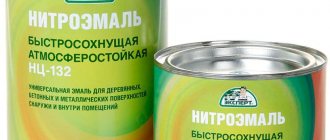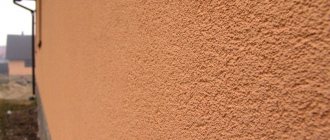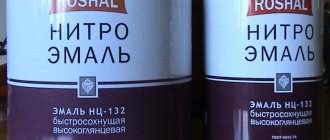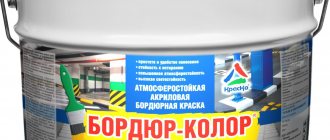Acrylic paints for walls and ceilings from San Marco fully meet the requirements of the international market. They are known in the field of construction and renovation, in the field of restoration of architectural landmarks and restoration. Interior acrylic paint can be used by both professionals and amateurs.
Like all products of the Italian manufacturer, acrylic paints from San Marco differ:
- Strength and durability. During operation, the coating does not lose color saturation.
- Environmentally friendly. The paints are hypoallergenic.
- Security. They are waterproof, fireproof, and resistant to sunlight.
- Functionality. Masks minor defects.
Water-dispersed acrylic paint for walls: features, properties and scope of application
Acrylic paints are also called water-dispersion paints. They contain a polymer acrylic dispersion and pigment. Acrylic dispersions are made from acrylic resins, which determine the technological properties of the paint, its resistance, durability, etc. It is allowed to dilute acrylic paint with water, which is the base of the paint. After applying the material to the surface, water molecules will begin to evaporate and resin particles will merge, forming a wear-resistant, durable and colorful layer. Pigment gives the material opacity and color.
Basic rules of work
It is better to find out what acrylic paint is and how to work with it before starting repairs in order to avoid difficulties and mistakes. Experts in the field of construction and repair recommend adhering to the following rules when using this finishing material:
- When purchasing large containers, you should pour the paint into a small container as needed during the work process to avoid drying out.
- To work, you need to use comfortable brushes and rollers. It is better to give preference to instruments made of cotton or with natural bristles.
- To dilute the color and make it less concentrated, use special acrylic-based substances rather than water.
- When applying, remember that water-based paints do not mix with each other on the surface, but are applied as the next layer, so to obtain the desired shade, first mix the colors in a jar.
- Prepare all auxiliary tools in advance to avoid materials drying out.
- The surface for further processing must be clean and free of grease. You can pre-prime it.
- At high air temperatures, the drying of the material accelerates, so it is better to carry out acrylic painting at +5-20 degrees.
- All imperfections should be removed before the material dries on the surface.
- In general, painting with acrylic does not require any special in-depth knowledge, so even a beginner can cope with the task. The main thing is to first understand how to use acrylic paints.
You can get the desired shade using machine or hand tinting.
Features and characteristics of acrylic paints
Acrylic paints for painting walls are intended for decoration inside residential and industrial premises. The prevalence of such paints is due to their excellent characteristics:
- no unpleasant odor;
- low toxicity;
- high drying speed;
- the ability to obtain a variety of shades by combining pigments;
- resistance to moisture;
- possibility of wet cleaning and cleaning of the resulting layer.
For a small surface, you can use aerosol paints. Material consumption can be reduced by first applying a layer of high-quality primer, such as Tintofis. For repairs and construction, paints in cans are used; for artistic crafts, acrylic paints in tubes are used.
Types of acrylic paint
Water-based acrylic paints for interior work, depending on their purpose, are divided as follows: for rooms with normal humidity conditions and for rooms with high humidity levels (kitchens, bathrooms, etc.). Based on their resistance to physical impact, washable and impact-resistant paints are distinguished. There are universal (combined) paints, for example, Valmarana Premium Matt, which are used for painting both ceilings and walls. There is also decorative paint for the ceiling on sale; this paint is notable for its low price, but it is not intended for wet rooms or walls that require frequent washing.
Interior acrylic paints are also divided into:
- Glossy. They shine brightly and beautifully (for example, Markotek AU). It should be used on a wall or ceiling with a perfectly smooth surface.
- Matte. A universal option that is suitable for ceilings and walls (examples: Armonia or Laguna). A discreet, delicate coating that emphasizes the elegance of the interior.
- Mother of pearl. To achieve a relief effect. Perlacheo paint is suitable for adding extra shine and personality to a room. Pearl effect paint for walls can also be applied with painting tools, such as a spatula or trowel, for a visual representation of the decorative effect. Or even serve as a protective glazing composition.
Textured paints can be classified into a separate category. They are more labor-intensive to apply, but will help create various effects on the wall. The most popular texture paints are:
- metallic effect paint;
- silk effect paint;
- sand effect paint.
Application technology
In order to obtain a high-quality result, the surface to be painted must first be cleaned of dirt and dust, and then primed. To do this, it is better to use a special composition or white acrylic paint diluted in half with water. If you ignore this process, the consumption of the finishing coat will double (both acrylic paint on wood and any other type are well absorbed into the base). If it is pre-coated with primer, much fewer layers will need to be applied.
If there is an old layer of paint, it is better not to experiment, but to remove it completely with a spatula. If this work is not done carefully, the result will not please you: the acrylic compositions are applied in a very even thin layer, and the presence of any defect is only emphasized and exposed.
Preparing walls for painting Source mtdata.ru
The direction in which the first layer of paint is applied does not matter. If the material is used to decorate walls or ceilings, it is better to apply the finishing layer towards the window. Then the finish will look perfect.
Before applying acrylic, glass and metal surfaces must be wiped with an alcohol composition, which allows the surface to be degreased. Then the paint layer will lie flat, and after drying the coating will be very strong and durable.
To choose the right color, you need to try on a separate piece of the material being processed. The fact is that acrylic paint for wood, metal, glass becomes a little darker after drying. It is important to pay attention to the structure of the composition. It can be glossy, matte, translucent and completely transparent. After hardening, it will be impossible to correct defects.
Acrylic paint darkens slightly after drying Source roomester.ru
Where is acrylic paint used?
Water-dispersed acrylic paint for walls and ceilings is not produced for a specific type of room; the paint is selected according to its intended purpose (for example, facade, especially resistant for places where the surface often gets wet, etc.). High-quality acrylic is practically not afraid of moisture, so water-based acrylic wall paints are successfully used in bedrooms, living rooms, kitchens, and baths. You can finish with acrylic directly using:
- tree,
- cinder block,
- brick slab,
- concrete slab.
There is a special type of San Marco acrylic paint for application to metal surfaces - Unimarc Smalto Micaceo. Preliminary puttying of irregularities and defects will help improve the appearance of the treated surface.
Preparing for coloring
Before painting the ceiling with acrylic paint or resurfacing the walls, you need to take care of the condition of the surfaces; the paint will not adhere if they are not properly prepared.
The first stage is cleansing
When the surface is new, plastered and smooth, you only have to clean it from dust. If the ceiling or walls were covered with wallpaper, they need to be removed. Usually, this can be done by simply moistening the old material generously and scraping it off with a spatula or scraper.
It is better to free the initially painted surface from the paint layer, especially if it has already cracked and peeled off in places.
The most difficult thing to remove is oil-based composition; you have to use a drill with a special attachment (a stiff wire brush or a brick crown), a hair dryer or a remover (a product for removing old paint).
For those who are puzzled by the question of how to remove acrylic paint, there is good news: if the coating is even, smooth and adheres well, then there is no need to remove it before repainting (just wash with soap). Otherwise, you will need to make an effort and work with a wire brush and sandpaper. Protective gloves and goggles will come in handy.
Stage two - leveling
When there are significant potholes, chips, cracks and other defects on the walls and ceiling, the surface must be leveled using starting and then finishing putty. The first is to fill deep flaws, wait for it to dry and sand it with sandpaper; wipe off dust. Using the second composition, the surface is finally leveled, dried and sanded with fine-grain sandpaper; remove all the dust again.
The third stage - primer
Before painting walls with acrylic paint or applying it to the ceiling, be sure to apply one or two coats of primer. It’s great if this product contains antiseptics; then protection against mold and other harmful microorganisms will be ensured. The main goal is to enhance the adhesion (adhesion) of the coloring material to the surface. The solution is applied with a paint roller or a wide flat brush.
What is included in acrylic paint
The classic composition of acrylic paints: filler, binder, coloring pigment. The binder is an acrylic polymer dispersion of acrylic resins. The colorful palette of the material is created by finely ground pigment, which, when mixed with a binder, remains suspended without dissolving. During long-term storage, separation of the mixture may occur: at the bottom of the jar there is a coloring pigment, on top there is an emulsion. Before starting work, the contents are thoroughly mixed.
The final properties of the material depend on the components: fillers, pigments, various additives (plasticizers, hardeners, antifoams). To improve adhesion, matting, and strengthen the paint film, filler (large pigment particles) is added. The viscosity of the paint is reduced by a solvent - water or an organic thinner.
With the help of additives (auxiliary components), the structure of water-based acrylic paint or paint film is changed after painting. There are additives that affect drying speed, transparency, thickness, etc.
How to dilute acrylic paints
Water-dispersed acrylic paint for walls has a fairly thick consistency, so for ease of application it is diluted before starting work. Another reason for paint thinning is that it remains open for too long.
The main diluent is water. Moreover, after applying paint to the surface, the coating will become waterproof.
The use of a thinner can significantly change the properties of acrylic paint, including:
- color and shade;
- layer strength;
- surface view.
To get the desired result, you must use thinners recommended by the manufacturer.
How to calculate acrylic paint consumption per m2
The manufacturer indicates paint consumption on the packaging. However, it is worth considering that the consumption rates are indicated for ideal conditions, a smooth surface and in a thin layer. In practice, the roughness and absorbency of the surface, as well as the method of application (roller or spray gun), are of great importance. It can be assumed that 5-15% more paint will be needed than what is written on the package.
Paint calculations are made after determining the area of the surface to be painted. Next, the area is divided by the standard flow rate. The result is the amount of material required for application in one layer. Paint consumption per 1 m2 can also be calculated using online calculators available on the Internet.
Peculiarities
Acrylic enamel is a synthetic water-soluble composition. The coloring pigment and water are bound together by a polymer, thus creating an emulsion. Adhesion, that is, the ability of 2 substances to penetrate each other well (in this case, the surface and the paint) is at the highest level. In addition, the thin film that forms protects the object from the destructive forces of the external environment.
Acrylic paints for decorative wall painting
Thanks to a wide palette of colors and high practicality, acrylic paints for painting walls and rooms have opened up a whole direction in wall decoration. Acrylic mixtures used in artistic painting are an aqueous dispersion of acrylic resins. Functional components provide the paint with additional properties: aesthetics, stability, strength after drying, resistance to high and low temperatures. Such paints can create a variety of three-dimensional visual effects, add relief and depth to the surface.
The selection of the required paint shades in specialized centers is done using a catalog, where each color has its own code.
Drawings are applied to the surface of the car using acrylic paints. With their help, chic patterns are made on a coating made using acrylic monomer.
Pros and cons of using
Thanks to the stable polymer film, all enamel paints with acrylic have a number of positive qualities:
- Safe for humans and animals;
- They are waterproof;
- Used in a wide temperature range;
- Preserve color;
- Contains antiseptics that prevent the spread of mold;
- They form breathable coatings under which condensation does not accumulate;
- Available in a wide range;
- Tinted, you can achieve the desired shade.
Along with the positive characteristics, there are disadvantages:
- There are few ready-made colored enamels; you have to additionally choose a color;
- Water-based paints cannot be stored at subzero temperatures; they must be stored in heated warehouses;
- The film hardens to full strength within a few days, before which the mechanical properties are weak.
After freezing, the properties of the enamel deteriorate significantly, and some paints and varnishes become unsuitable for use.
Contains antiseptics that prevent the spread of mold.
Types of acrylic-based paints from San Marco
The range of acrylic paints from the Italian manufacturer San Marco is quite wide. The company produces interior paints (for interior work) and facade paints (for exterior work). San Marco produces innovative paints that meet modern requirements.
They fit well on the surface being treated, creating a uniform layer, and are characterized by long-term operation. You can choose glossy or matte paint that is impact-resistant, washable, moisture-resistant, high-performance, and at a cost that will fit your budget. All paints from this brand are of high quality.
Popular manufacturers
The products of foreign and domestic manufacturers are widely represented on the market.
Imported mixtures:
- You can highlight the Dulux brand with original products for various surfaces;
- Sniezka Ultra Biel enamel contains optical suppressors and is white.
Domestic products:
- Consumer demand is high for enamels produced;
- It produces a wide range of acrylic paints;
- Under the Expert brand you can find special enamel for radiators;
- It produces heat-resistant products;
- Universal mixtures are valued;
- Novbytkhim produces high-quality flooring compounds.
You can highlight the Dulux brand with original products for various surfaces.
When carrying out interior work, it is better to give preference to special paints for certain surfaces.
Polymer acrylic present in the enamel creates a beautiful glossy surface. Thanks to the introduction of additives, manufacturers have learned to produce paints with varying degrees of gloss. Acrylic paints are valued for their ease of application, durability and environmental friendliness.
How to paint walls or ceilings with acrylic paint
If you decide to do the painting yourself, but do not have the technique of a master, you should familiarize yourself in detail with the procedure for performing the work and the properties that acrylic enamel paint has. This modern material is used to create different interior styles, including Art Deco, which is characterized by high aesthetics and luxury. The colors of acrylic paints from the San Marco brand make it possible to emphasize interior features by selecting the desired tone. At the same time, the material will protect the walls from the appearance of mold and mildew.
To ensure good adhesion, the base is carefully prepared:
- you need to clean and wash off the old coating;
- apply putty, sand it;
- get rid of dust;
- apply primer.
Prepare the composition of the required thickness. The paint thinner is water. The ceiling is processed first. The correct execution of further steps involves painting it in one go, so that the acrylic paint does not dry out and its transition is not visible. This can be attributed to the disadvantage of this material.
Correctly selected, high-quality tools play an important role:
- special bath;
- rollers;
- tassels;
- sponge.
Nothing better has been invented yet than acrylic paints
Coatings formed with acrylic paints are practically harmless: they have high resistance to UV radiation, elevated temperatures, and extremely high oil, water, and salt resistance. Moisture-resistant acrylic paint does not peel off or crack even on problematic surfaces. It comes in glossy, semi-gloss, matte, semi-matte, and dazzling white. The stability of the gloss gloss can be traced throughout the entire period of operation.
Other advantages include: excellent coverage, economical consumption, formation of a vapor-permeable coating, environmental friendliness, tinted in any shade. This paint will solve any problem.











